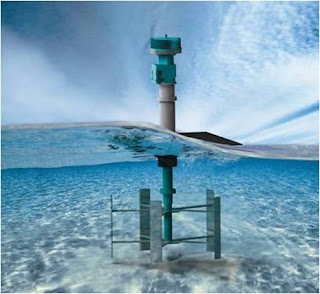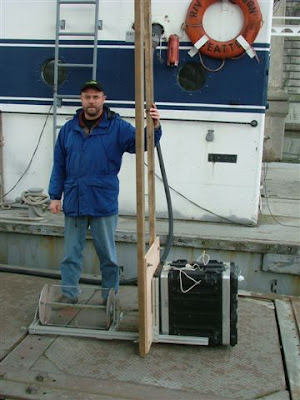 I've been spending a lot of time on posts about some of my passions--renewable energy, climate change, energy politics, and other things--I haven't spent nearly enough time on Hydrovolts technology. So, let's talk turbines.
I've been spending a lot of time on posts about some of my passions--renewable energy, climate change, energy politics, and other things--I haven't spent nearly enough time on Hydrovolts technology. So, let's talk turbines.First, some terminology:
- A turbine is the complete device, containing all parts that turn moving water into electricity, and especially the rotor, the generator, and the power electronics.
- A rotor is the part that spins in the current. For most turbines this looks like a propeller made of several blades, often similar to those used in modern wind turbines (but smaller and proportionally thicker.)
- The generator converts the mechanical energy (typically of a rotating shaft) into electricity through the use of magnets and wire windings.
- Power electronics take many forms but for turbines are necessary to both transform the electricity produced by the generator into the right form (e.g. AC or DC) and to condition the power by smoothing out voltage spikes, reducing line noise, etc.
- One important kind of power electronics is the inverter, which changes direct current (DC) into alternating current (AC). AC is used in the electrical grid, the wires in our homes and many large appliances. DC is used in cars, consumer electronics and most battery devices.
- A power cable brings generated and conditioned electricity to where it is used or to a point of transmission.
- Deployment hardware provides a way to position the turbine in service. This hardware varies widely with the size of the turbine, its type, and details of the site.
A key element of the Hydrovolts turbine is its unique rotor design. Most hydrokinetic turbines use a horizontal axis design where the axis of rotation, the shaft, is positioned parallel to the current flow. The moving current presses on two or more blades mounted radially from the shaft, causing it to rotate. Examples include the design from Marine Current Turbines:

Verdant Power has a 3-bladed design they have been testing in New York's East River (actually a tidal flow rather than a true river.) The mounting pylon is designed to rotate, allowing the turbine to capture power both on the incoming and outgoing tides:

The Clean Current turbine has several blades and differs from the previous two by placing the spinning blades in a cowling. This both allows a venturi effect to increase the speed of the water flow and somewhat shields marine life from the fast-moving blade tips:

These three designs all use horizontal axis rotors as part of their hydrokinetic turbine designs, but these companies are pursuing a different business from Hydrovolts. All primarily target utility scale power generation in tidal flows rather than small scale generation in freshwater flows. Hydrovolts business grew out of founder Burt Hamner's successful effort directing a study for Tacoma Power to assess the feasibility of tidal energy in the Tacoma Narrows. The study concluded and Tacoma Power agreed
that tidal generation will not be feasible in the Tacoma Narrows waterway for at least eight to 10 years and that other renewable resources, like wind power, are more economically feasible at this time.Burt realized that, although feasible tidal power remained a distant prospect, the same kind of hydrokinetic technology could be shrunk down and deployed in many other places in a way that would have near-term feasibility.
Some other companies have had a similar idea.
Hydro Green Energy intends to place utility-scale devices using a horizontal axis design in permanent installations adjacent to existing hydroelectric dams. They installed their first 100kW unit in Hastings, MN a few months ago:

Free Flow Power has aggressively pursued Federal Regulatory Energy Commission (FERC) permits in the Mississippi River to place arrays of horizontal axis turbines, each with 7 blades:

Unlike these others, Canada's New Energy Corporation (EnCurrent) uses a vertical axis design. The rotating shaft extends from the rotor blades in the current flow up through a deploying raft to the generator and electronics above the surface:

The Hydrovolts rotor design is different from all of these, as it uses a cross-axis design where the rotating shaft is perpendicular to the water flow and parallel to the water surface. The design is similar to a paddlewheel or old-fashioned water wheel with one very significant difference: the Hydrovolts design is fully submerged. It is like a paddlewheel that can spin entirely under water:
The Hydrovolts cross-axis design has several significant advantages over competing designs:
- Simple: The flipwing blades are flat sheets rather than more complicated propeller blade designs. Flat blades can be made in many places and of many materials without expensive machinery or costly tooling.
- Robust: Because the blades are simple the turbine suffers little loss of efficiency if they are damaged, e.g. by denting or warping. Foil designs will be more severely impacted.
- Safe: The Flipwing turns at the speed of the current and has no tips or edges that could slice marine life, e.g. fish.
- Low fouling: Initial tests show that water-borne debris rolls over the top of the Flipwing, unlike with horizontal axis turbines which become easily entrained with material that wraps around the shaft.
- Adaptable: Almost all competing designs have a swept area (the working cross-section of the current) that is circular, so non-circular channel geometries cannot be efficiently harnessed. The Hydrovolts Flipwing is rectangular, and can be built to exactly match water flows of different dimensions, such as those that are wide and shallow.
- Scalable: The Hydrovolts Flipwing design can be manufactured to fit watercourses of almost any size both by scaling the individual device and by ganging together multiple turbines to maximize the swept area of an available channel.
- Easy Deployment: The Hydrovolts turbine is fully submersible and floats in the current. No watercourse modification (dams, penstocks, pilings, poured concrete) is needed. The turbine can literally be tossed in and held in place with deployment hardware as simple as two chains anchoring the turbine to each bank. (Other deployment hardware and options are available.)
- Low Cost: Simple rotor design, easy installation, and a compact design keep manufacturing and deployment costs low, resulting in much faster capital ROI for buyers.

The raft was placed in the water and towed behind a research vessel at carefully calibrated speed, simulating the current flow of a stationary turbine in a flow of the same speed:

The Hydrovolts team used these and other results to improve the prototype design and to attach an initial generator design:

Company founder and Flipwing inventor Burt Hamner has continued to lead the Hydrovolts effort to produce a new generation of improved hydropower devices:

Further in-water tests using the boat-tow method continue to yield good results:
Recent lab test results validate the power output Hydrovolts expects its production units to make. Additional prototyping work is ongoing. While there are various design and optimization issues still to be finalized, we are pleased with the excellent results and the rapidity of our current progress. Based on the prototyping success, Hydrovolts is building the first of several demonstration units:

This unit will be placed in service within the next 3 months, with others to follow based on the needs of our development effort and based on feedback and interest from our customers.

Those interested in learning more or hosting a demonstration unit are invited to contact us.

Power from waterTM. The light bulb is on!







No comments:
Post a Comment